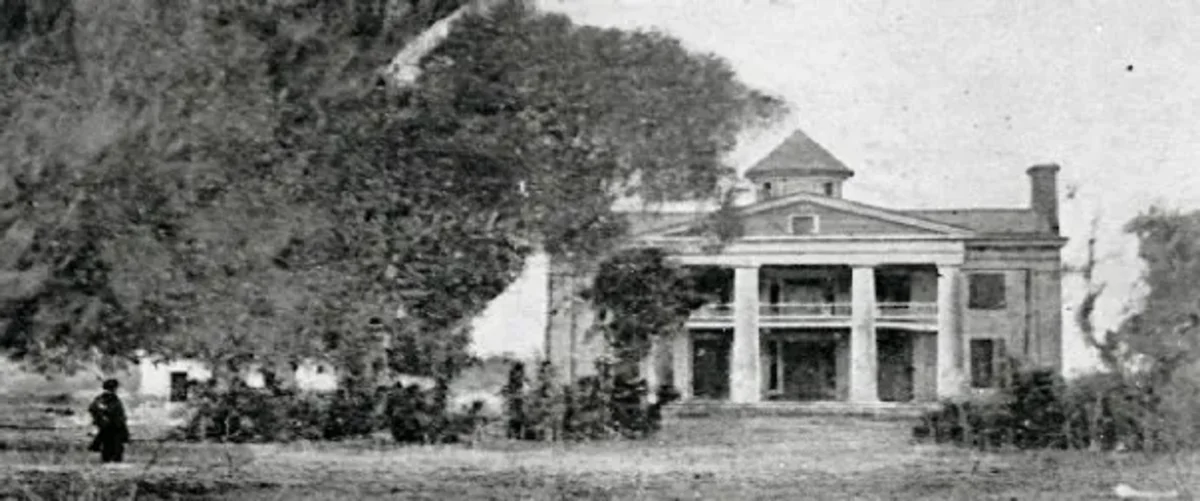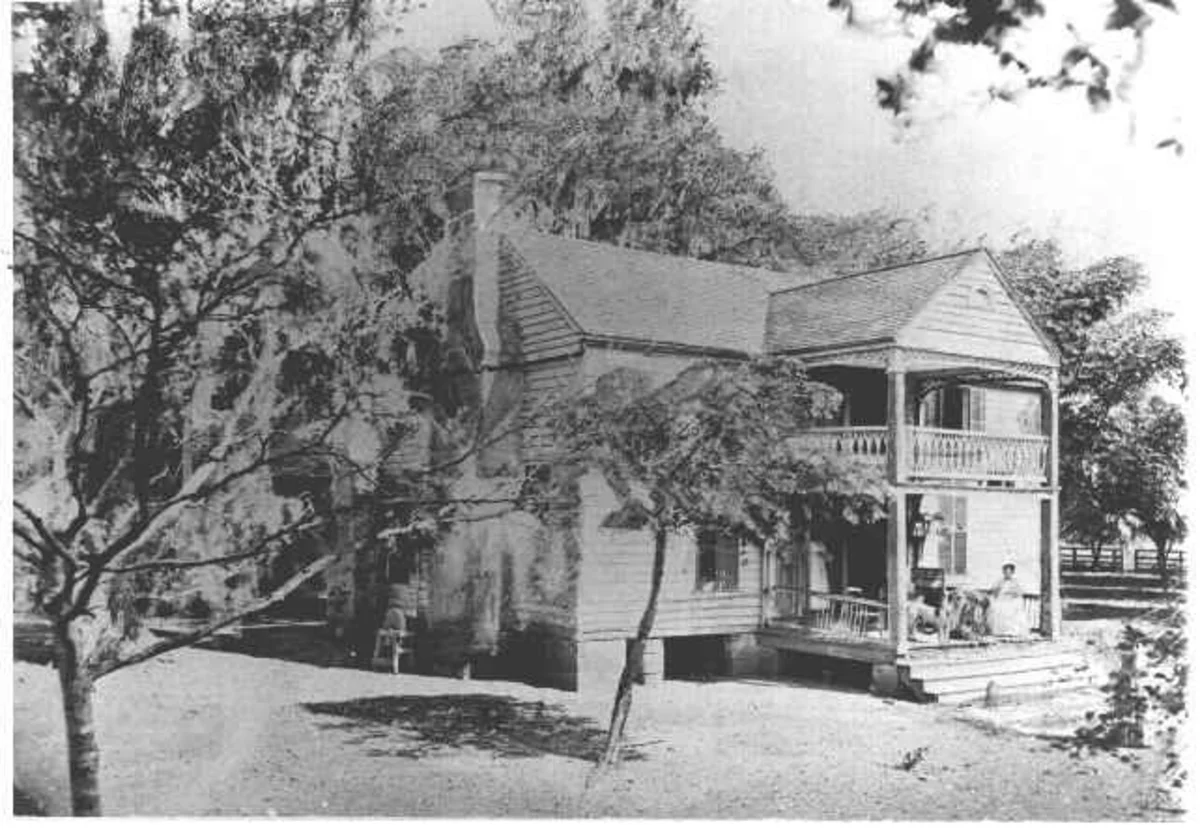![]()
By Tracy Gupton
Columbia Historical Museum
Before the Civil War came to its bloody conclusion, Brazoria County was home to many large plantations. And the West Columbia/East Columbia area between the Brazos and San Bernard Rivers boasted a hefty share.
The Pattons were an “Old 300 Family” that made the long, arduous trek to Southeast Texas from Louisiana with Stephen F. Austin in the early 1820s. The Brazoria County cities of Lake Jackson and Sweeny are named for large plantation owners whose reliance on slave labor reaped huge monetary benefits for the plantation owners.
By 1861, more than 70 percent of the population of this region of Texas were enslaved people, the heaviest such concentration west of the Mississippi River, according to author John R. Lundberg whose book, “The Texas Lowcountry,” was published by Texas A&M University Press earlier this year.
In his research for “The Texas Lowcountry: Slavery and Freedom on the Gulf Coast, 1822-1895,” Lundberg focuses on plantation life in Brazoria, Wharton, Fort Bend and Matagorda counties before and after the Civil War. He writes that there were seven plantations on the west side of the Brazos River, “from the Josiah Bell plantation north to Orozimbo, the plantations of Dr. James Phelps.”
Lundberg, a professor of history at Tarrant County College South and associate editor of the East Texas Historical Journal, recently spoke at the Varner-Hogg State Park near West Columbia about his new book. He told his small audience on the grounds of the Varner-Hogg mansion on the banks of Varner Creek that the two best-developed plantations in the West Columbia area were the Patton and Osceola plantations, owned by Columbus Patton and James G. Hill throughout most of the antebellum period.

“Although Martin Varner established the plantation in 1824, it was Columbus Patton who purchased 13,500 acres from him in 1834,” Lundberg writes in his new book about the plantation that Ima Hogg donated to the State of Texas in 1958. “Patton then had the enslaved on the plantation construct a two-story brick house, facing northeast, on the west bank of Varner’s Creek, a small tributary of the Brazos with steep banks. Completed by the 1850s, the house stood as one of the sturdiest brick houses in the county.
“The enslaved also constructed the sugar mill, with a double set of kettles, and slave cabins of brick made from the mud of the creek,” the author goes on to write. “The sugar mill stood 125 yards northeast of the house, across Varner’s Creek, and some of the slave cabins were 120 yards north of the sugar mill.”
A story written by William Polley that was posted on the Texas Historical Commission’s website December 2, 2023, said that, in Brazoria County alone, there were 63 plantations. “A coastal region with rich soils, long growing seasons, and access to markets by transportation systems, Brazoria County was a premier agriculture producer and once home to the capital of Texas,” Polley wrote. “The state’s enslaved population grew rapidly. In 1845, there were about 30,000 enslaved people in Texas. By 1860, that number had increased to 182,566.”
Abner J. Strobel, who was born on the Drayton Plantation in Brazoria County in 1858, published a book in the 1920s entitled “The Old Plantations and Their Owners of Brazoria County, Texas.” Strobel’s book can be found in the West Columbia public library. In it, Strobel writes that Stephen F. Austin left New Orleans in November 1821 to lead the first body of Anglo immigrants into Texas. According to Strobel, they reached the Brazos River on December 31, 1821, “proceeded up that stream and on January 1, 1822, pitched camp at a creek on the west side of the Brazos in what is now Washington County. From this time on, the colonists came in increasing numbers during the years 1823 to 1830.
“Brazoria County was settled in 1823 by Josiah H. Bell, Brit Bailey, Joseph H. Polly, Prim, the Bradleys, Amos and Daniel Rawls, Damon and a little later by David Tilley, James and John T. Beard, Thomas Westall, T.J. Pilgrim, the Fenns, the Shipmans, John D. Pitts, John Brown Austin, W.D.C. Hall, the Alsburys, Millburn, Mrs. (General) Long, Major Calvit and John Austin settled at the town of Brazoria in 1828,” Strobel writes. “About this time James F. Perry, brother-in-law of Stephen F. Austin, arrived in the county and settled at Peach Point. They had for neighbors, the McNeels, Mills, Hawkins, Munsons and others.”
Of the many plantations in Brazoria County from the 1800s Strobel writes about in his book, the John Sweeny Plantation, the Josiah Bell Plantation, the Patton Plantation, the Waldeck Plantation, the Osceola Plantation, the Maner Plantation, the Phelps Plantation, and the Willow Glen Plantation are those that once thrived as very productive cotton and sugar plantations near West and East Columbia.
William Polley writes in his Texas Historical Commission post from last year that Martin Varner, the original owner of what is today the Varner-Hogg State Park, “sold his plantation in 1834 to the Patton family from Kentucky, who traveled to Texas with 12 enslaved Africans. The enslaved workers turned the land into a booming agricultural complex. At the height of production, they produced 245 hogshead barrels of sugar using enslaved labor.”
Columbus Patton came to Texas in the early 1830s from Kentucky with his parents, John and Margaretta Patton, brothers St. Clair, William and Mathew and sisters America Patton Aldridge and Margaretta Patton Murphee.
A story found online at www.tshaonline.org about plantation life in early Brazoria County reveals that, between 1850 and 1860, just prior to the start of the War Between the States, there were 19 sugar, 16 cotton, and three plantations that produced both sugar and cotton. “Before the war, these plantations produced an average of 7,000 to 8,000 hogsheads of sugar annually, and up to three-fourths of the state’s output in 1857,” that story said. “The cotton industry flourished in East Texas, where enslaved labor became most widely used.”
Abner Jackson Strobel, who died in 1931 at the age of 72, is buried in the Angleton Cemetery. His grandmother married Abner Jackson after her first husband, John Strobel, died as a young man. Major Abner Jackson, who the city of Lake Jackson is named for, developed two plantations in Brazoria County, the first being the Retrieve Plantation. Major Jackson came to Texas from South Carolina after Texas had won its independence from Mexico. Lake Jackson Plantation was created during the period 1842 to 1845.

Strobel writes in his book that, “Major Jackson, up to the beginning of the war between the states, had the finest and highest developed properties in the county, and owned three sugar plantations, 70,000 acres of land and over 300 slaves.”
When Abner Jackson died in 1861, his son John C. Jackson returned home from fighting for the Confederacy to find his family’s vast properties in poor condition. “Desolation reigns supreme and the sighing winds sing a requiem through limbs of trees that now grow amidst its ruins,” said John Jackson, according to his relative by marriage, Abner Strobel.
Strobel wrote in his book that the Willow Glen Plantation “lied on the east side of the Brazos River about a mile above the town of Columbia and to the right of the Columbia Tap Railroad as you go west into the station at Columbia.” He wrote that, previous to the Civil War, “it belonged to a family by the name of Campbell. At the close of the war or soon after it passed into the hands of a mercantile firm at Galveston. It was a good sugar plantation.”
Strobel said Willow Glen passed from the Galveston firm to the Jarvis and Craig families who operated it for about 20 years, “and made good crops every year.” Strobel writes in his book that Willow Glen was eventually sold to J.L. Dumars who operated the plantation near West Columbia for several years before it “passed into the possession of some loan company.”
The Maner Plantation was a cotton plantation, according to Strobel’s book. Maner Lake near East Columbia is named after the family who once owned Maner Plantation. It was located north of the Osceola Plantation on the Brazos River.
The Osceola Plantation was the home of William G. Hill, who came to Texas from Tennessee. Hill developed it as a cotton plantation. He was elected to the First Congress of the Republic of Texas Senate and was a Worshipful Master of St. John’s No. 5 Masonic Lodge in West Columbia from 1850 to 1851 and was an original member of the local Masons in 1838, according to Scott Leopold’s 2012 book, “St. John’s Lodge No. 5: Masons in the Early Days of Texas,” which can be found at the Columbia Historical Museum in West Columbia.
Hill’s Osceola Plantation adjoined the Waldeck Plantation, which joined the Patton Plantation on the north and was later owned by the Texas Oil Company. Strobel wrote in his book that the Waldeck Plantation was “opened up in an early day by Morgan L. Smith of Massachusetts. It was the finest equipped sugar plantation in the country, and was indeed a beautiful place. I can see it now with several thousand acres of waving cane and corn as far as the eye could see.”
Strobel claims the Waldeck Plantation was the first sugar refinery in Texas. He said in his book that Smith was also a merchant at Columbia who was said “to have carried a stock of a half million dollars.” Strobel goes on to write that the towns of Columbia and neighboring Brazoria had other merchants in the 19th century, “among them John Adriance in Columbia, and Robert and D.G. Mills, and Patrick McGreal of Brazoria. John Adriance told the writer that he had taken in as much as $5,000 in cash in one day, besides his credit sales, and business was mostly done on credit in those days.”
Hamblin Bass, born in 1816 in Georgia, lived in Alabama before moving to Texas. In November 1859 Bass acquired the Waldeck Plantation. It has been reported that Bass owned 213 slaves that worked the Waldeck Plantation’s 1,450 acres. The Waldeck Plantation was three or four miles from present day West Columbia.
The John Sweeny Plantation lied on what used to be known as Chance’s Prairie (modern day Old Ocean area). Strobel wrote in his book that John Sweeny had two sons, Thomas and William Sweeny, who fought alongside Sam Houston in the Battle of San Jacinto. In 1837 slaves built the house on John Sweeny Jr.’s plantation, using only brick, nails and wood made on his land. The Sweenys produced molasses, cotton and sugar on their vast acreage near the present day towns of Sweeny and Old Ocean.
A Texas State Historical Association story about John Sweeny Sr. (1783-1855) written by Diana J. Kleiner reveals that the Sweeny family arrived in Texas from Norfolk County, Virginia, around 1832, cleared the forest near the San Bernard River using slave labor and developed a large sugar plantation, establishing gristmills and several cotton gins.
After Mexican General Antonio Lopez de Santa Anna was captured at San Jacinto in April of 1836, he was held prisoner at Martin Varner’s Plantation near present day West Columbia. When Sam Houston feared his fellow Texans would kill Santa Anna at the Varner place, the future president of the Republic of Texas had the Mexican president moved to Dr. James Phelps’ home, both for medical treatment after Santa Anna was poisoned as well as for safe keeping. The Phelps Plantation was developed as a cotton plantation, according to Strobel’s book. It was also known as Orozimbo and is located off County Road 255 near East Columbia on the Brazos River. A state historical marker sits on this isolated piece of land where the Phelps family’s plantation home once stood.

And the Josiah H. Bell Plantation eventually, over the passage of time, became the town of West Columbia. Josiah, his wife Mary, and their children came with Stephen F. Austin to Texas with the original “Old 300” and founded both the communities of East Columbia and West Columbia in the 1820s. East Columbia was originally known as Bell’s Landing and Marion before Columbia was originated on the Bell’s property where West Columbia is now.
In William Polley’s story on the Texas Historical Commission’s website, the Levi Jordan Plantation State Historic Site Educator wrote, “Initially, slavery was not allowed in Texas under Mexican rule. Later, Stephen F. Austin gained an exception to the law from the Mexican government to entice more Americans from the United States to settle in Texas; thus, slavery gained a foothold by 1824. For many African Americans who were enslaved at the Levi Jordan and Varner-Hogg plantations, the only record of their existence lies in what they created.”
Lundberg writes in his new book on slavery in Brazoria and connecting counties, “Levi Jordan established a cotton and sugar plantation in 1848. The enslaved at the Jordan plantation built the plantation house from boards of long leaf pine brought from Florida. They also handmade the studs and sills of the house from oak, and bricks were used to construct the fireplaces and chimneys of the two-story mansion, as well as the slave quarters and sugar mill.”
Both the Levi Jordan Plantation near Four Forks outside of Brazoria and Sweeny and the Varner-Hogg Plantation State Park are now owned by the Texas Historical Commission. Tours of these two area former 1800s plantations can be taken by visitors.
Varner-Hogg Plantation state historic site can be contacted by calling (979) 345-4656 or online at visitvhp.com.

Very well done! Thank you for lots of information we didn’t know! From Trish Donaghey, wife of John E. Donaghey, both doing well in our 80’s in N. TX.